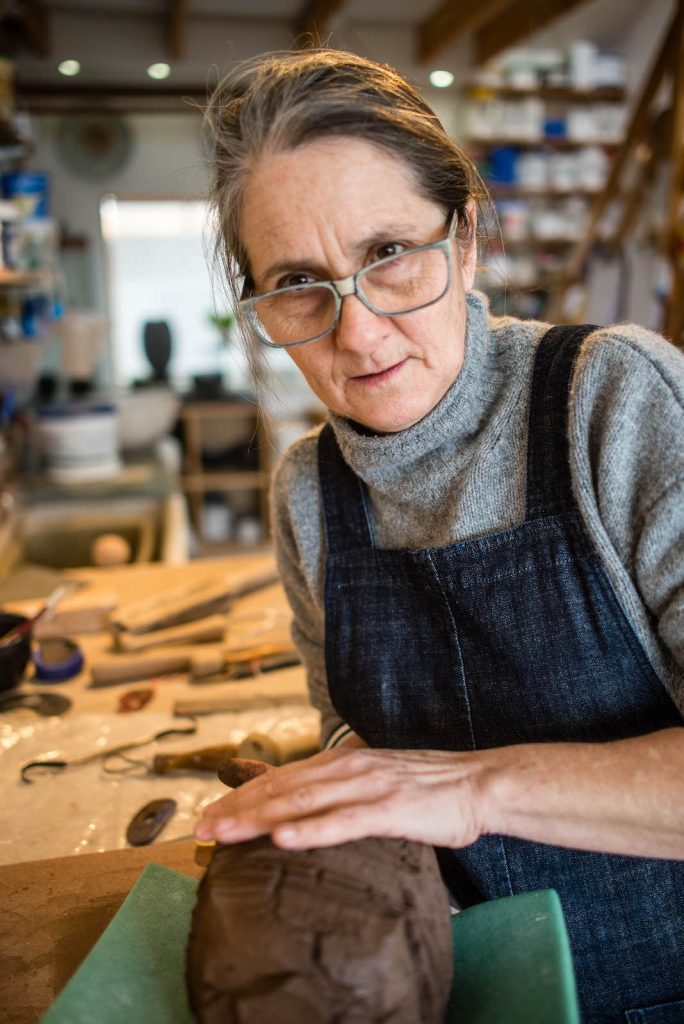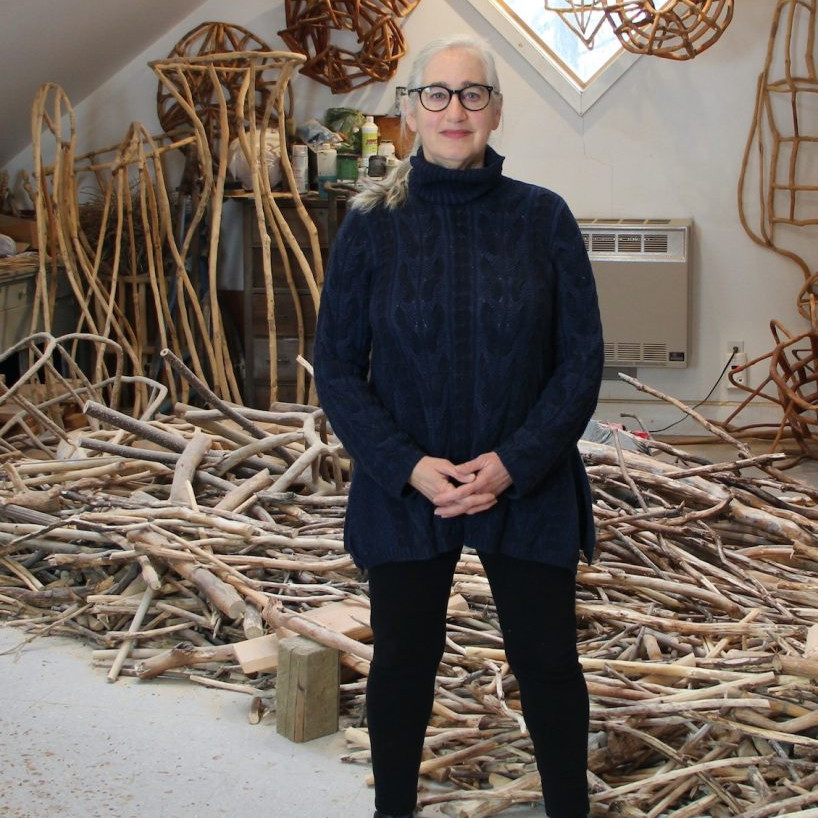Patricia Shone Ceramic Artist
Your method is very manual and physical discuss.
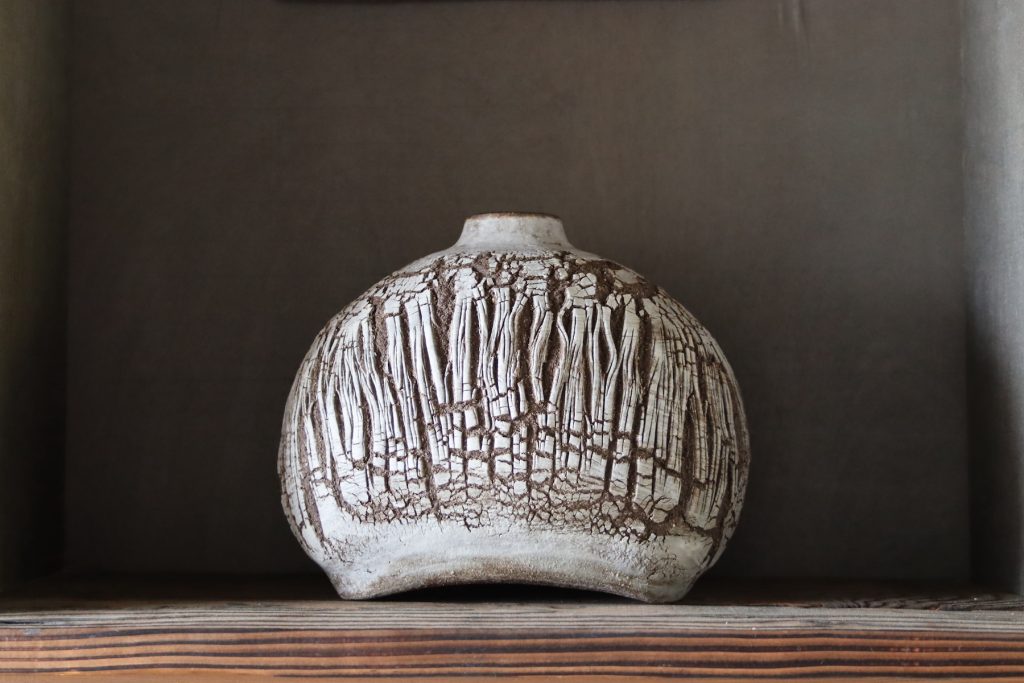
Forest Jar, 2021, height 23cm
The feel of soft clay in my hands and between my fingers. Years of working with it developing strength in my body giving me control in my work which connects me to the physical world around me, beneath my feet. Being aware of living in a body which works well feels like a dance. Movement and activity balancing the mind. All these contribute to the work I make, physicality connecting directly to inner inspiration. Some time it feels like kneading the Earth and I’m actually a rubbish dancer.
How has this affected you physically?
For most of my life I have been fit and strong and coped well with the physical rigours of making ceramics (and 12 years of cheffing). Occasional bouts of carpel tunnel syndrome which always improved with rest. Middle age brought with it the massive drop in oestrogen and I lost all its wonderful anti-inflammatory properties. I felt the beginnings of frozen shoulders. I was in the early stages of learning techniques of making textured work on the wheel which became impossible with the pain and restricted movement in my shoulders. It was this condition which led me to work out how to make small textured pieces by hand building. This is what I have been developing ever since.
I now use a regime of yoga and walking and to be aware of how my joints are coping with any given task. ‘Old age doesn’t come by itself”
Watch this video and see the construction techniques
What type of clay do you use?
I use various types of clay, mostly highly engineered from the Potteries in Stoke on Trent. The texturing and stretching techniques which I use stress the clay and open up its matrix, weakening it, rather than compressing it. When the clay is then subjected to raku firing, wood firing and extreme reduction the stresses are even greater. The clay has to withstand all of that.
I use a couple of raku bodies, great for thermal shock and low shrinkage; a couple of crank clays, similar properties, higher fired and more interesting colour results in wood firing; a black firing clay and some porcelain, both temperamental. I recycle all the scraps of all of these all together which usually gives me the most exciting results in the wood kiln.
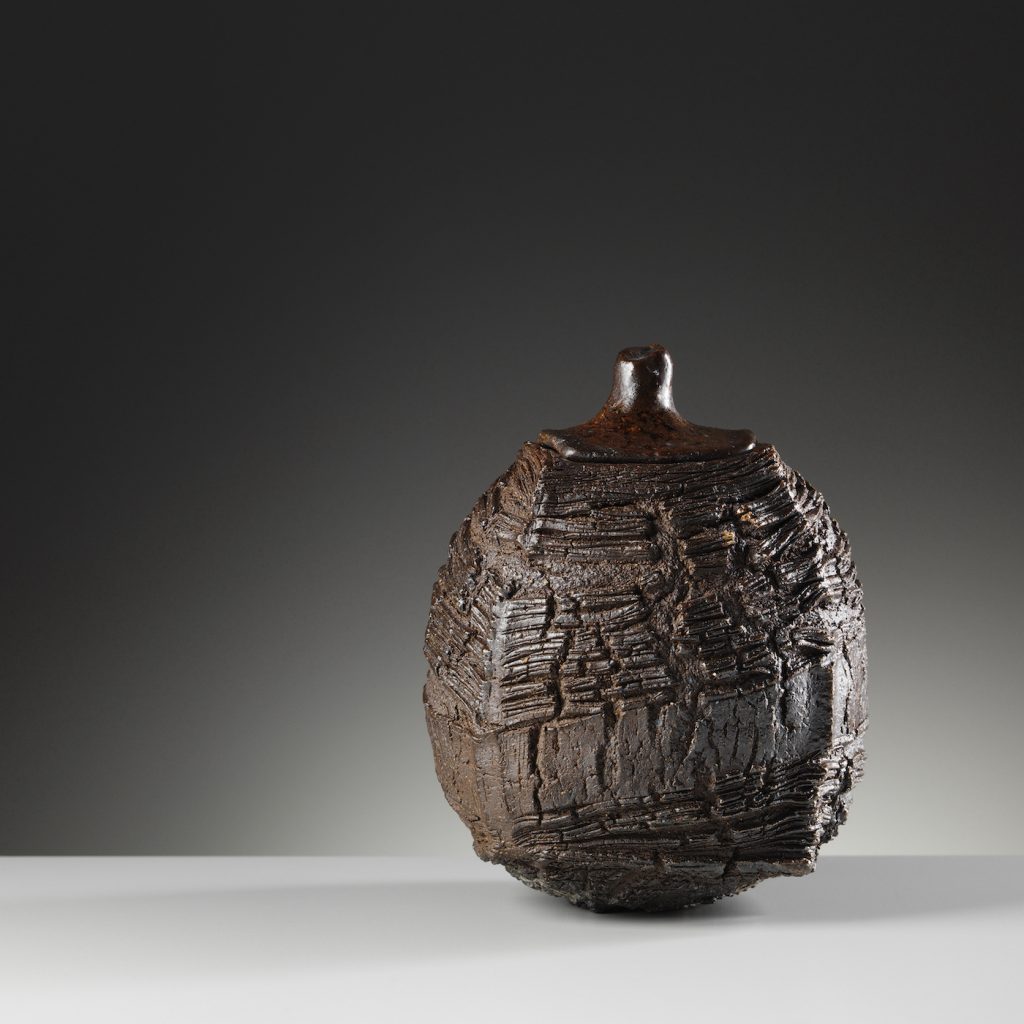 Lidded Erosion Jar. ht16cm.wood fired. Image ShannonTofts. 2017
Lidded Erosion Jar. ht16cm.wood fired. Image ShannonTofts. 2017
There is very little wild clay on Skye, the rivers are too short and most glacial deposits have been washed away. There are a couple of small deposits which I am experimenting with as glaze ingredients.
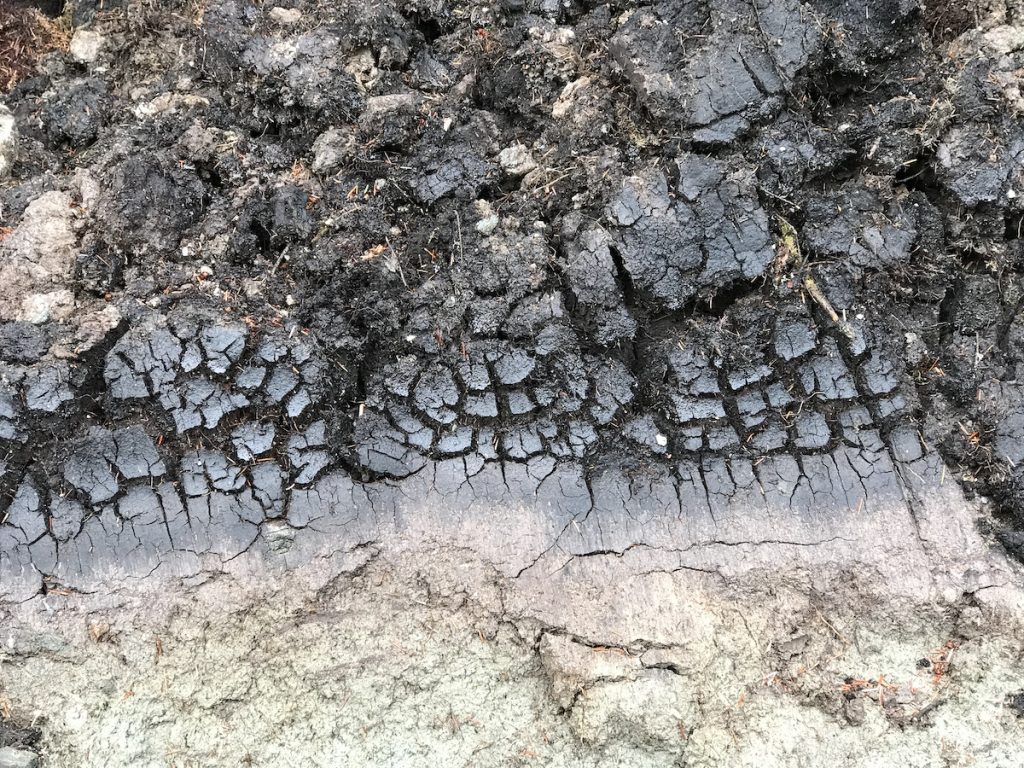
Peat erosion
How has living and working on Skye influenced your ceramics?
It would be hard not to be influenced by these surroundings, it’s quite an immersive experience living here.
There again it’s hard to know as I haven’t lived anywhere else whilst working full time on my ceramics.
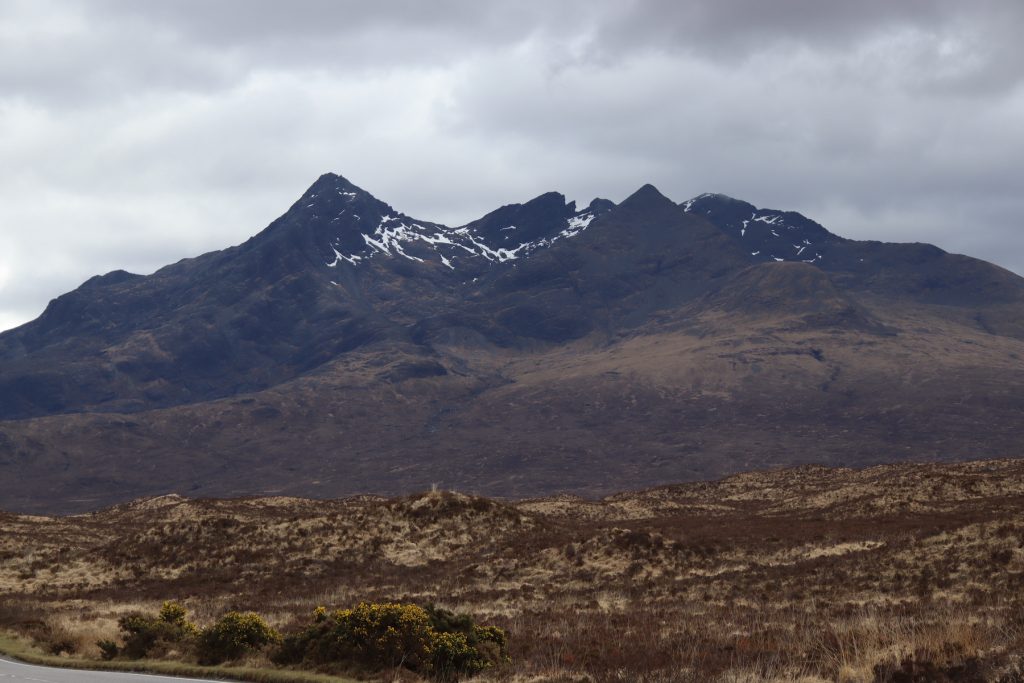
The Cuillin Range, Skye.
I do feel I was brought here and it feels uniquely and perfectly suited to both me and my work. It’s all inseparable. The path of accepting and learning to love all the aspects of living here is also the path along which my work has developed. Problems and issues that living here raised within me, that I needed to deal with, were the problems that were blocking my work. I’m thinking of things like confidence, self-worth, expectation & disappointment, trust in my own vision, belonging. Belonging is a big one, it’s very strong amongst local people here and I had to find and claim my own sense of belonging. As a child of an itinerant family, I never felt I came from anywhere, which is freeing but also lonely. The 2014 independence referendum kind of forced me to stake a claim!
When and why do you use the wheel?
Initially I was throwing texture pieces, practicing the techniques I learned from Shozo Michikawa, a master of these twisted, energetic forms. I got to the level of being able to make a virtue of throwing badly. I had to stop when my shoulders problems began.
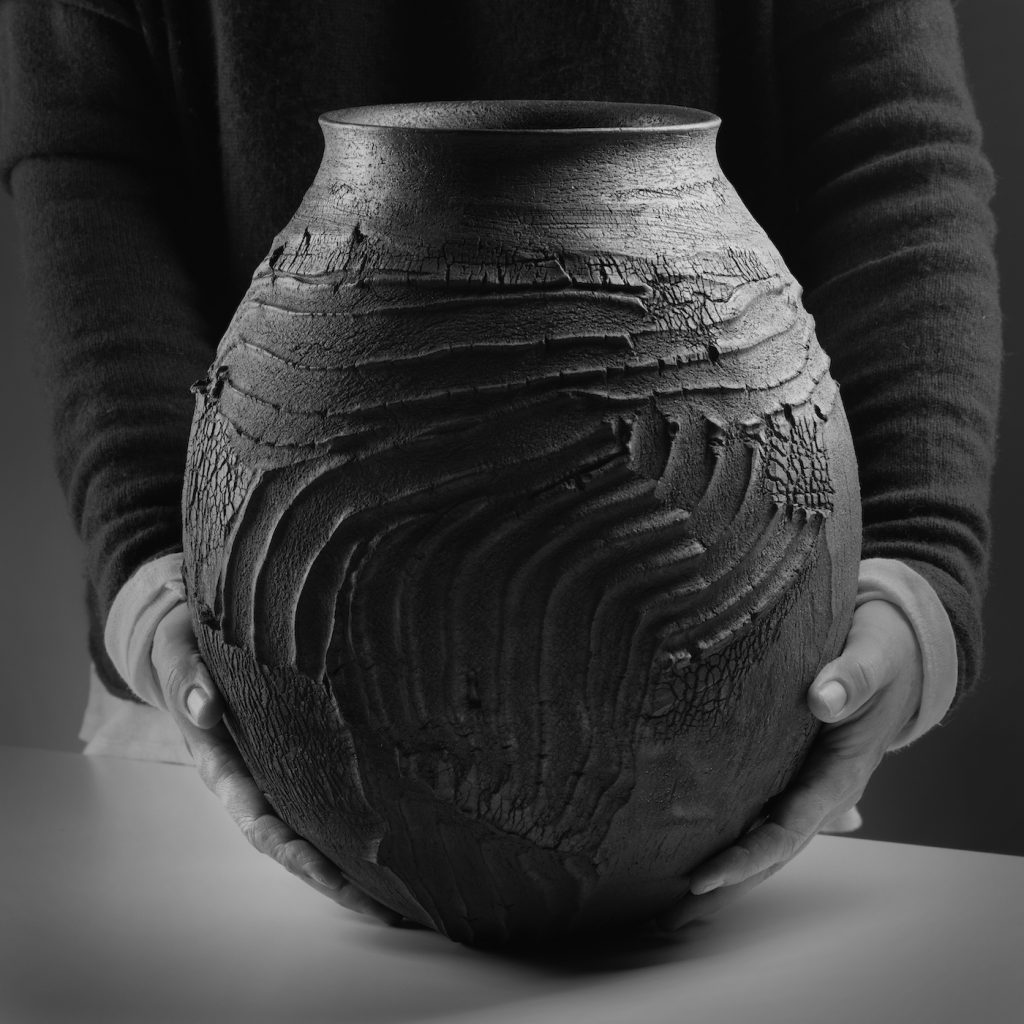
Erosion Jar, 32height x 34cm, image Shannon Tofts
I admire the skill of repetition throwers but I don’t have the patience for it myself. Occasionally I throw and alter some cups and bottles, just to keep me connected to the reality of function and closer to the craft of pottery than to sculpture.
What brought you to Raku?
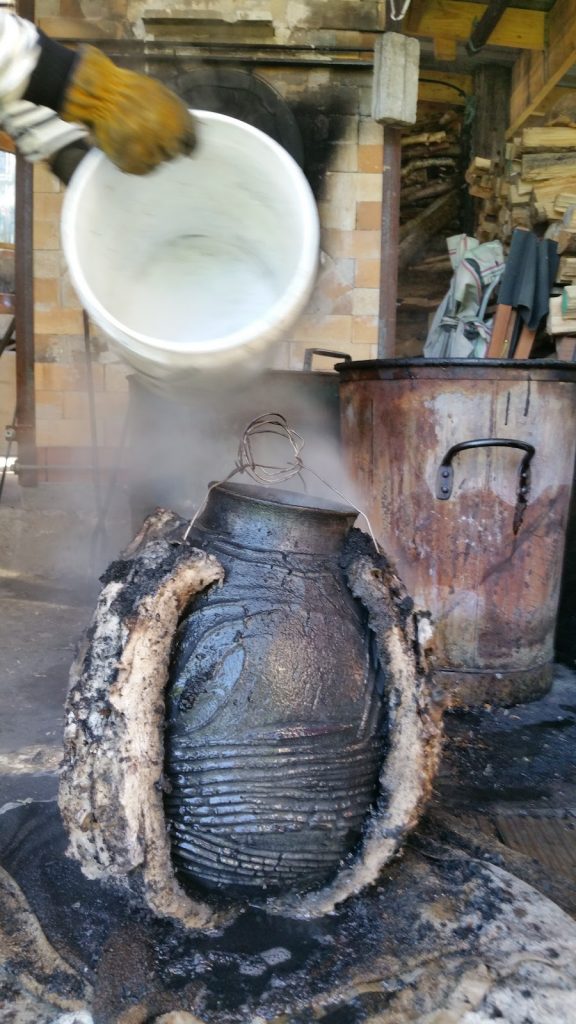
Big pot
I was at art school in London in the 1980s studying ceramics. There was very little kiln building or firing but we did get a long weekend of raku firing at a tutor’s studio out in the countryside. Nearly 20 years later when I returned to making ceramics it was the simplest and least intimidating way to start playing with it again, both financially and creatively. I rather fell in love with the soft, deep blacks and greys of the unglazed clay surfaces that develop with the post firing reduction of western raku technique.
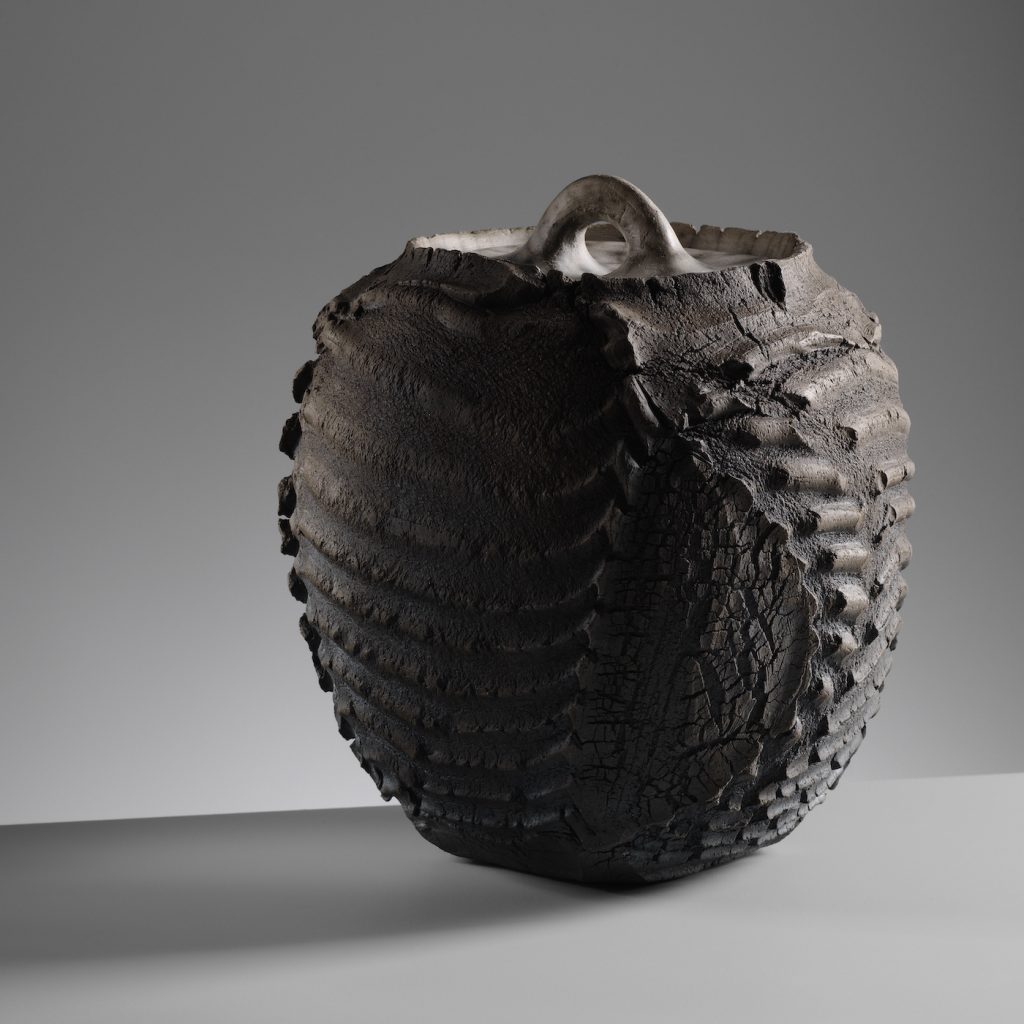
Lidded Erosion Jar, height 16cm, wood fired, image ShannonTofts, 2017
You say, “The landscape can be very dominating.” Discuss this in relations to your art.
This landscape in this climate is not an easy place to walk through, literally unless there’s a path and you’re well prepared. It’s such an obvious metaphor for life.
Walking along old tracks out on the hill I’m aware of the many other footsteps that made that path. Here am I adding my own whilst obliterating those of previous travellers, all helping to keep the path open. There’s a sense that nature is waiting to wrest control again, the moment we stop walking that path. It’s both reassuring and unnerving. It’s not a comfortable landscape, you can’t ignore it and imagine that humanity can exist here without hard work. There’s a humility required and a stubbornness. The soil is thin, the summers are short, the sea is cold, the midgies are relentless, the wind can knock you down, the air is exquisite and the light on the hills takes your breath away.
Discuss your work in relationship to caring for the environment.
I have left this one to last, dreading it really and the conclusions I know I will be faced with. This is the big issue. I’m writing this with COP 26 happening over the hills in my nearest city. The Highlands just had one of the driest summers on record (making it actually one of the loveliest). But there are few fish to catch in the sea and not so much bird song which used to wake me at 3 in the morning as the sun came up. Ceramic production requires high energy – wood, gas or electric. Raw materials come from all over the world. I drive my work to shows or send it with carriers. It all adds carbon dioxide to the atmosphere. The small efforts I can make, reducing, reusing and recycling, seem very small indeed. Potters are generally very frugal in their working practices, there’s not much to cut. The kilns have only ever been fired full. My use of wood as a fuel came about, apart from interest in the results, because our power supply here is too weak to fire to stoneware with electricity. Recently I wonder if this is the last generation of studio potters who will be able to fire in reduction, which requires a combustible fuel. No more copper reds and green celadons?
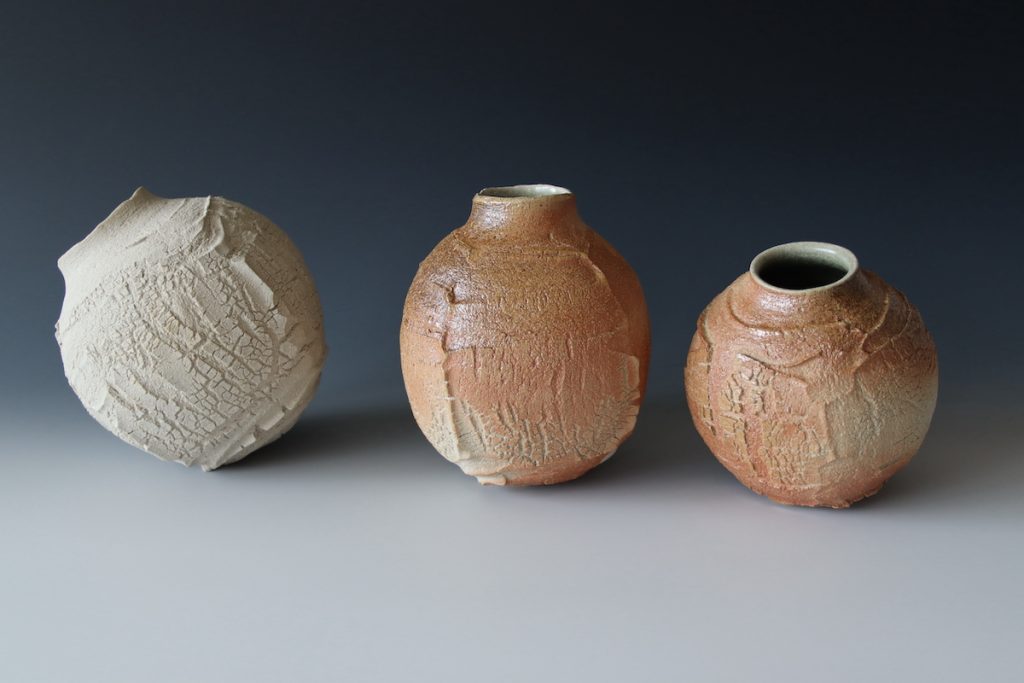
Three Globe Jars. WoodFiredStoneware.2020, artist image
On the domestic side we look after the croft land around us, dealing with invasive weeds, maintaining meadows and encouraging biodiversity, planting trees, growing fruit and veg organically. We shop local, eat local meat, have an air source heat pump and a wood burner for when the power goes off.
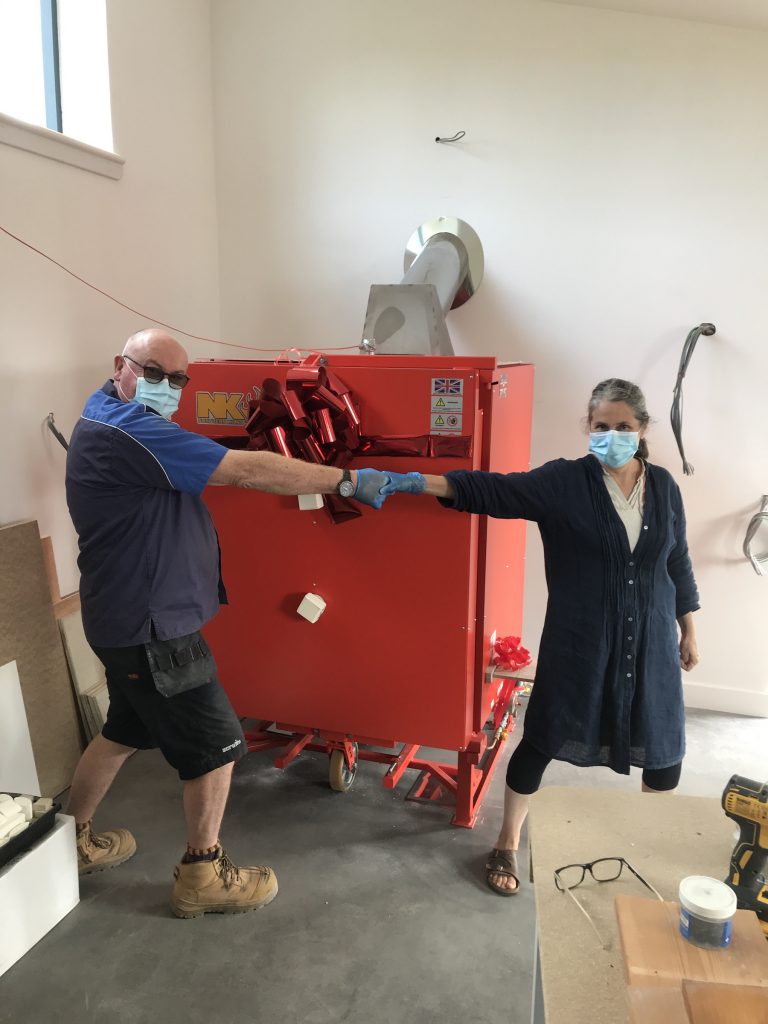
Installing Big Red Mary during covid
The biggest contribution I could make would be to stop making/firing my work. I don’t think it is something I can do. It feels more like penance, a self flagellation of the spirit, and would it add to the general sum of happiness? More questions than answers I’m afraid.
Comment on your involvement in Potfest – Scotland.
Potfest is just that – festivals of pottery, run by a potter family with potters and pottery collectors at it’s heart. They are joyful gatherings where we meet our friends, make new ones and get to see the whole spectrum of ceramic work. So much more than just sales. I see very few fellow potters in any year, let alone have the chance to handle and talk about our work. Many collectors come to the events as the standard of work is astonishing considering it all takes place in tents in Scotland! It gives the visitors a chance to meet, talk to and learn from the potters. It’s a very levelling event to take part in. During the pandemic many shows were cancelled but Potfest rescheduled theirs and managed to find those sweet spots between the lockdowns. The Scottish Potfest at Scone Palace in September 2020 was the first event of the summer in the area. Helped by glorious weather and being safely outdoors we had double the normal number of visitors, many for the first time. I think any event would have drawn the crowds, we were all desperate for something positive to happen. The joy of it helped many of us face the winter lockdown, both financially and emotionally.
How large can you construct a piece and what are your perimeters?
The largest pieces I have made so far with the stretching techniques are about 40cm in diameter, 50cm in height using about 12kg clay at the start of the process. I usually work from small pieces to large pieces over the course of a few weeks, rather like weight training. The weight of the clay can easily crush the textures and I have to be able to manoeuvre the mass of textured clay without that happening.
You have recently (2020) moved your studio after twenty years.
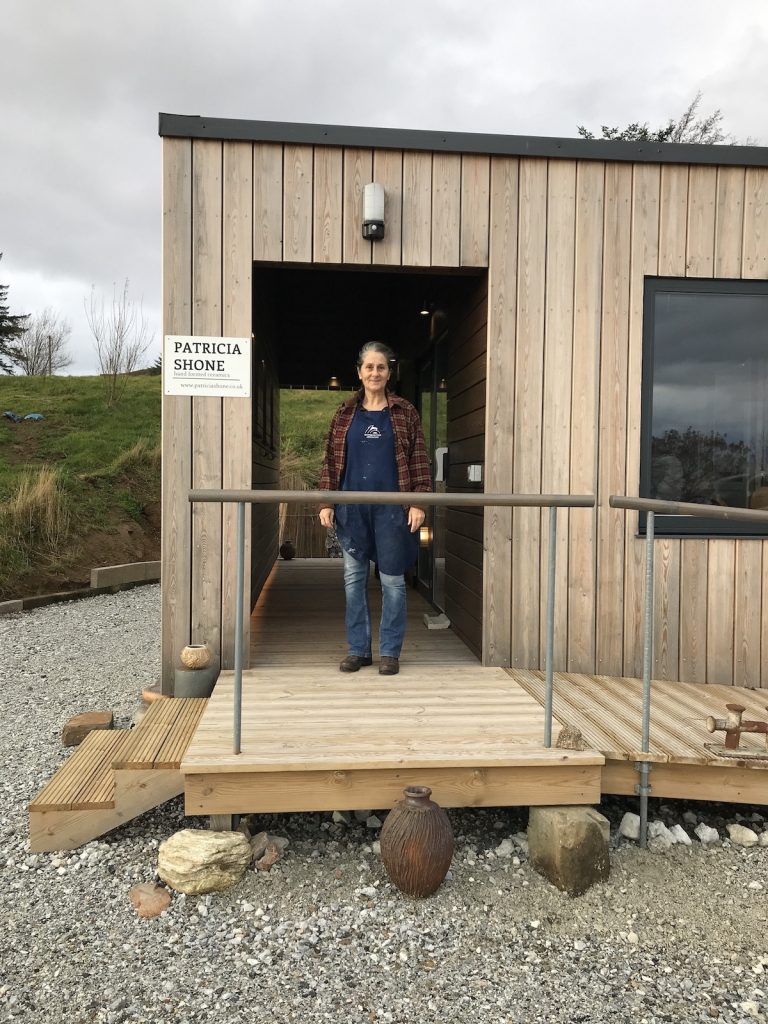
Fearna mor Studio Studio step
The old studio was converted from a small garage attached to the house. After 20 years it was full, leaving very little space for making more than a couple of pieces at a time, which was problematic as I use many different clays. Recently we were able to buy the croft surrounding our house and this gave us a potential site to build. I haven’t moved far, just down the hill. The advantages are many, it’s 4 times the size giving me separate areas for working the different clays.
I have a small gallery space now to display the work away from the dust and mess of the workshop. The short walk to the studio in the morning starts my working day away from the distractions of the house. No more displacement activity, as long, as I get through the garden without stopping.
The setting of the new studio makes the most of the view with it is ever changing light from reflections of the sea and sky.
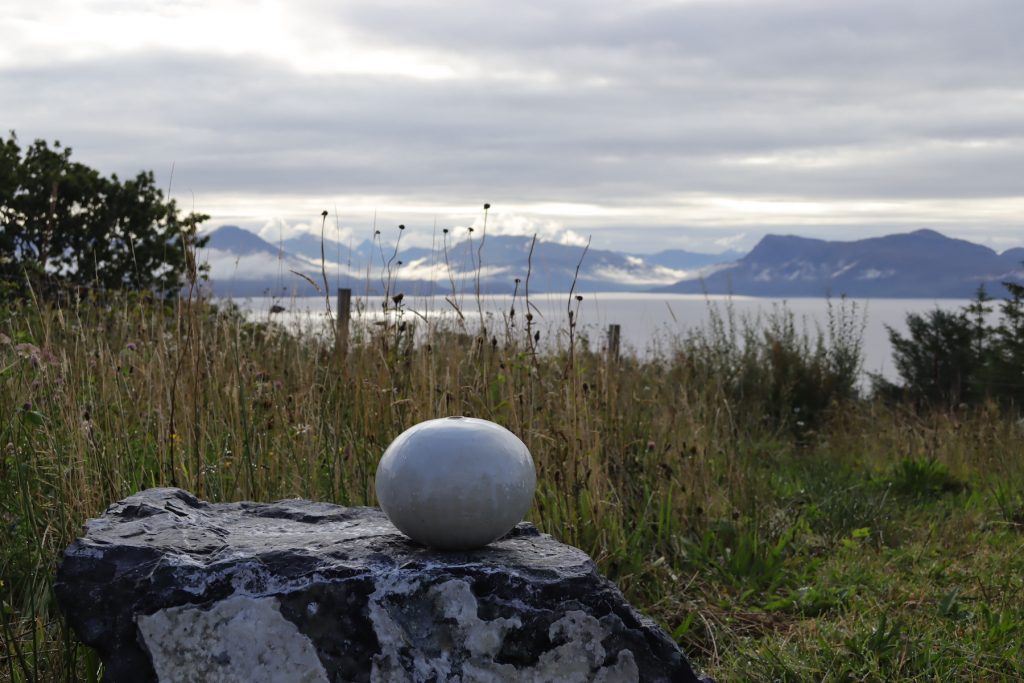
Studio view
The value to me is unquantifiable, in life and work. I am taken aback by how my work has developed, and the success it has achieved. It has required as much work on myself to accept the success as it has taken to develop the skills to make the work. Valuing my work to the point of building myself a studio is still uncomfortable and something I work on understanding.
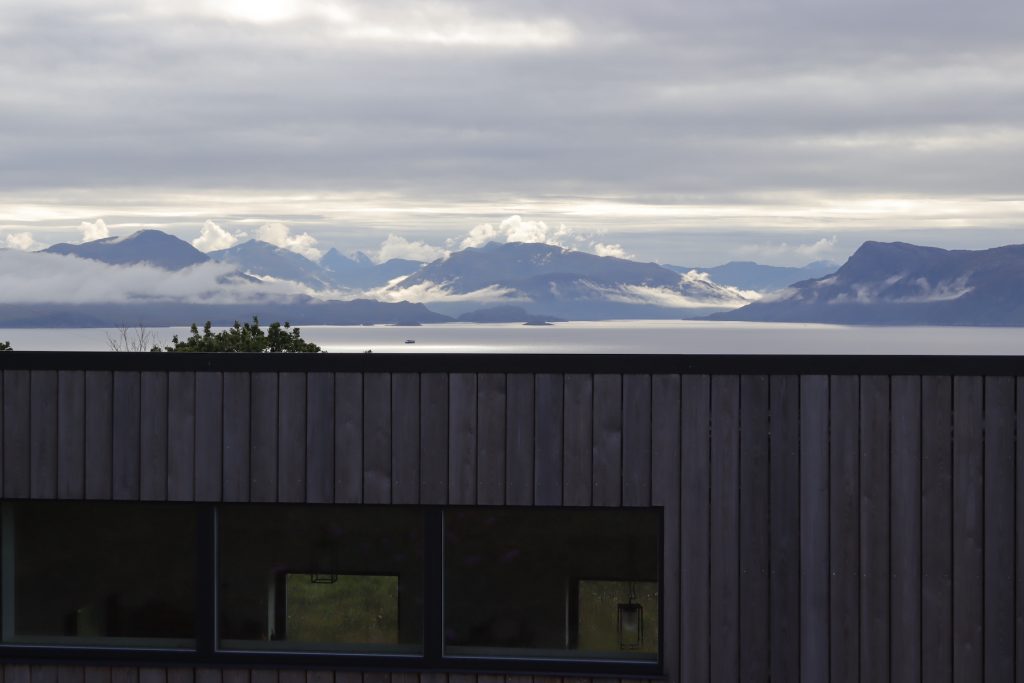
Studio view
How has Covid 19 affected you and your face-to-face interactions with you buyers and open studios?
It’s been fascinating as we’ve opened, up again from the lockdowns. I discovered that a little splinter of suspicion of strangers had developed, a little voice saying “who are they? what are they doing here? Have they brought the pestilence?” Of course, it evaporates as soon as we talk, and feel the relief of the kind human contact. We’re all feeling it. Visitors are so important to help resist that drift towards isolation. They help me see this land again with fresh eyes, returning me to the core of my work. I feel I owe it to share what I have here, something in it resonates with people.
I do like that little bit of extra control I have over when visitors come to the studio. I’m now open by appointment, and ask people to message or email, it just gives me time to prepare myself. Covid has allowed me to make that necessary rebalancing.
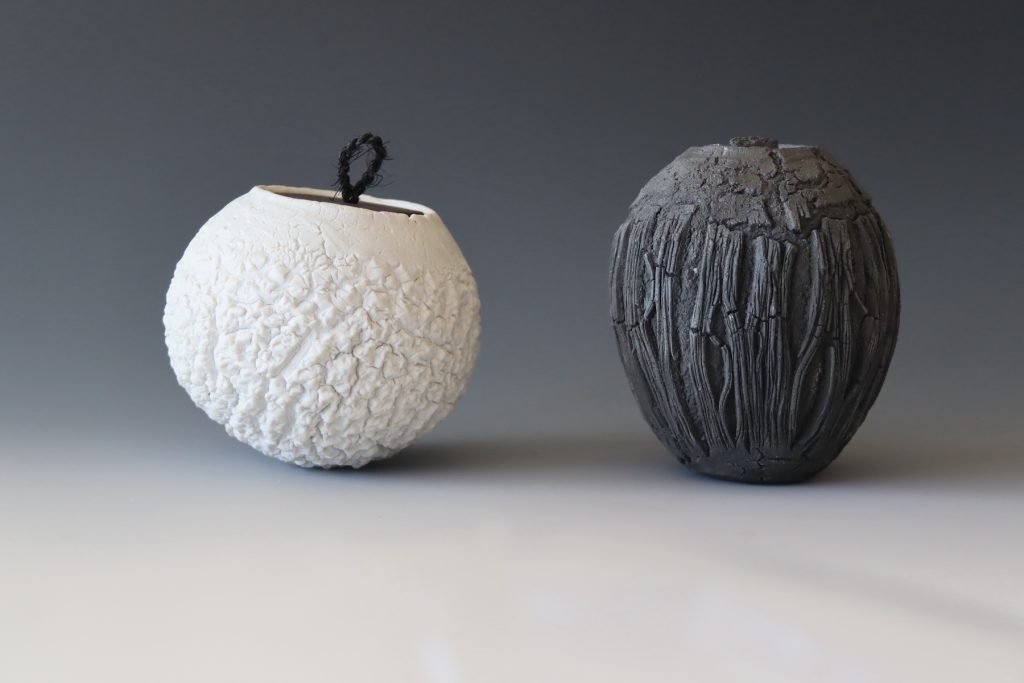
Lidded jars porcelain and saggar fired height 10cm
What do you think you will take from the Lockdowns and the pandemic as an artist?
Initially the shutdown of everything was a huge relief. After 10 years of busy and hard work combined with issues of ageing family at the other end of the country, I was happy to stop for 2 or 3 months. The quiet and stillness was exquisite. Just when I was ready to start again my body said no! Niggling aches and pains turned into full blown inflammatory conditions and I couldn’t do anything with my hands for months. So there’s no ‘Great Art Work’ to summarise this extraordinary time, I struggled even to hold a toothbrush. I did nothing, just lived through it like most of us. Fallow periods are always good for the creative soil, it allows the compost to rot down well.
Contact:
Patricia Shone
on Instagram @patriciashoneceramics
Deborah Blakeley, Melbourne, Australia
Interview by Deborah Blakeley, November 2021
Think a colleague or friend could benefit from this interview?
Knowledge is one of the biggest assets in any business. So why not forward this on to your friends and colleagues so they too can start taking advantage of the insightful information the artist has given?
Other artists you may be interested in:


